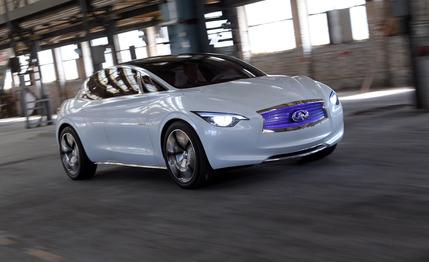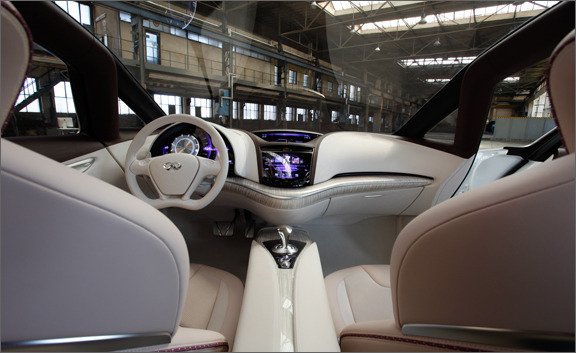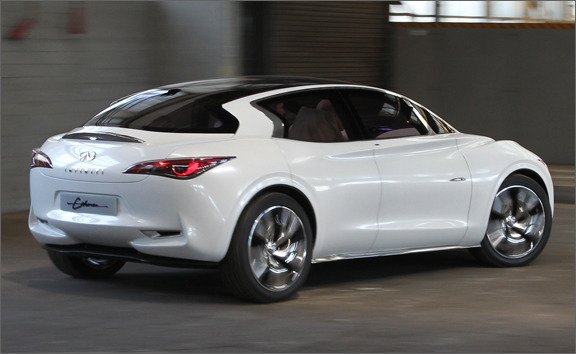 Prototype Drive
Prototype Drive
It is extremely rare for automakers to invite journalists to drive their concepts, so we didn’t hesitate for a second when Infiniti Europe's Wayne Bruce offered to let us take a spin behind the wheel of the compact Etherea. Launched in March at the Geneva auto show, the Etherea is, unlike many other concept cars, not just the next series-production car on slightly bigger wheels. Although the Etherea points to a compact Infiniti that could be reality in as little as three years, we can safely assume that the production car won't share much with the carbon-fiber skin of the concept.
That would be quite all right with most of us who saw the somewhat awkward car on the Geneva turntable, but the Etherea does look better in motion, more powerful and muscular. The front end is attentive and focused, with aggressive eyebrows over the headlights that are certain to inspire the next generation of the G and other Infinitis. At night, the grille is illuminated in Infiniti's signature purple, an effect we don't expect to see on the street any time soon. The glass roof offers an unobstructed view of the sky, and a somewhat less extreme version, with a bit more bracing, could make production in the future. The C-pillar features a pronounced backward kink, an exaggerated variation of the same element on Infiniti’s M, which gives the compact concept a strong visual push forward.
Looking Forward to Front Drive
The Etherea is Infiniti's first front-wheel-drive concept, although not its first front-wheel-drive car. That honor belongs to the G20, a dressed-up version of the first- and second-generation European-market Nissan Primera sedan. Since the demise of the Maxima-based I35 in 2004, Infiniti has defined itself as a rear- and all-wheel-drive brand, so the Etherea’s design targets included achieving rear-wheel-drive proportions on a front-drive platform. In our view, this mission has been accomplished: The 173-inch-long Etherea—only about an inch longer than a BMW 1-series—bears precious little resemblance to any front-drive Nissan.

Japanese design details abound inside. Shiro Nakamura's design team liberally applied washi-paper-style décor, the vertical inserts on the lower part of the doors are inspired by inuyarai bamboo, and the piping on the seats is kumihimo Japanese braiding. The interior is full of lighting effects—and full of light-colored leather, one of Bruce’s people notes, making sure we forfeit all leaky ink pens and aren’t wearing shoes with dark rubber soles when the time comes to get behind the wheel.
Despite the Etherea’s being a concept car, it is very comfortable inside, and the control layout is familiar. Looking through the steering wheel, the driver sees a large round tachometer sitting on the left, with concentric arcs to the right displaying speed, hybrid-system info, and fuel level. A nav screen is tucked up near the windshield, but below that, the center stack is dominated by a screen through which the driver controls HVAC and infotainment functions. The futuristic look is underscored by blue illumination on the doors and in the IP. There is no center console connecting the dash to the futuristic shifter; Infiniti says it wants to see if the public sees a traditional center console as part of its brand DNA. As long as there’s still space to stash our junk, we’re fine with the open look.
Although the seating position upfront is perfect, Infiniti will need to work on the packaging if the production car is supposed to be anything more than a two-plus-two. The suicide rear doors and the lack of a B-pillar make getting in back a snap, but there’s not a lot of room behind the front seats. The four separate and distinctively styled seats look great, although they’re clearly just a concept-car embellishment.
Ethe-Real
Fire it up, however, and the Etherea becomes very real. Power is channeled to the front wheels through a continuously variable transmission with standard, eco, sport, and snow modes, and paddles mounted on the steering column allow manual selection of pretend gears.
We were not permitted to subject this one-of-a-kind concept to our regular testing, but we did manage a fair impression of its real-world behavior. The chassis and steering of the Etherea behave in a reassuringly normal manner, and takeoff is brisk. The sound insulation is good, but with a grille that looks like it's about to suck up the exosphere, the four-cylinder buzz from the dual exhaust pipes is a bit underwhelming. Overall, though, the Etherea is remarkably refined, even if a few of the screens are still nonfunctional.
The production compact based on the Etherea is slated for launch in late 2013 or early 2014. It will compete with the Audi A3, BMW 1-series, and Lexus CT200h, as well as the upcoming Mercedes-Benz A-class. We’re still divided on the looks of the Etherea, but the styling will no doubt be toned down before production. And the car’s mainstream appeal is far greater than that of the other compact Infiniti that will come to market in 2013: a Nissan Leaf–based electric sedan.
